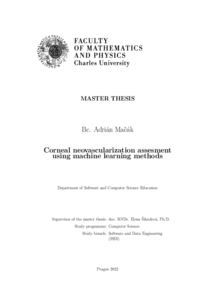Corneal neovascularization assesment using machine learning methods
Vyhodnocení neovaskularizace rohovky metodami strojového učení
diploma thesis (DEFENDED)

Item with restricted access
Whole item or its parts have restricted access until 07. 09. 2025
Reason for restricted acccess:
protection of intellectual property, particularly protection of inventions or technical solutions
View/
Permanent link
http://hdl.handle.net/20.500.11956/176376Identifiers
Study Information System: 244353
Collections
- Kvalifikační práce [11326]
Author
Advisor
Referee
Holeňa, Martin
Faculty / Institute
Faculty of Mathematics and Physics
Discipline
Software and Data Engineering
Department
Department of Software and Computer Science Education
Date of defense
13. 9. 2022
Publisher
Univerzita Karlova, Matematicko-fyzikální fakultaLanguage
English
Grade
Excellent
Keywords (Czech)
hluboké učení|detekce cév|rohovka|neovaskularizace rohovky|machine learning|segmentace obrázku|medical image|U-NetKeywords (English)
deep learning|vessels detection|cornea|corneal neovascularization|machine learning|image segmentation|medical image|U-NetV našej práci sme sa pokúsili pomôcť oftalmológom s ich výskumom liečby - rohovkovej neovaskularizácie. Masívne zlepšenie hardvéru a algoritmov v strojovom učení otvárajú nové možnosti riešenia problémov v medicínskych snímkoch. Počas tejto práce sme vy- tvorili unikátny dataset a riešenie používajúce umelú inteligenciu, ktoré kvantifikuje toto ochorenie. Riešenie pozostáva z výpočtovej a užívateľskej časti. Výpočtová časť používa hlboké konvolučné neurónové siete s prispôsobenou U-Net architektúrou na detekciu a segmentáciu rohovkových ciev. Užívateľské rozhranie poskytuje nástroj pre oftalmológov na kvantifikáciu snímok pacientov. Experimentálne sme naše riešenie nasadili do nemoc- nice FNKV Praha na výskumné účely. 1
In our work, we tried to help ophthalmologists with their research on treating - corneal neovascularization. The massive improvement of hardware and algorithms in machine learning opens new ways to solve many medical imaging problems. During this work, we created a unique dataset and AI-powered solution which quantifies this disease. This solution consists of the computational and user interface part. The computational part uses the deep convolutional neural network with customized U-Net architecture to detect and segment corneal vessels. The user interface provides a toolkit for ophthalmologists to quantify patients' images. Experimentally, we deployed this solution to the hospital FNKV Prague for research purposes. 1
